Unit - 3
Point to point protocol
Point - to - Point Protocol (PPP) is a communication protocol of the data link layer that is used to transmit multiprotocol data between two directly connected (point-to-point) computers. It is a byte - oriented protocol that is widely used in broadband communications having heavy loads and high speeds. Since it is a data link layer protocol, data is transmitted in frames. It is also known as RFC 1661.
The main services provided by Point - to - Point Protocol are
- Defining the frame format of the data to be transmitted.
- Defining the procedure of establishing link between two points and exchange of data
- Stating the method of encapsulation of network layer data in the frame.
- Stating authentication rules of the communicating devices
- Providing address for network communication.
- Providing connections over multiple links
- Supporting a variety of network layer protocols by providing a range os services
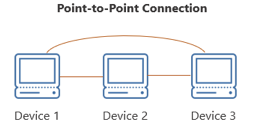
Fig 1: Point to point connection
Point - to - Point Protocol is a layered protocol having three components −
Encapsulation Component − It encapsulates the datagram so that it can be transmitted over the specified physical layer.
Link Control Protocol (LCP) − It is responsible for establishing, configuring, testing, maintaining and terminating links for transmission. It also imparts negotiation for set up of options and use of features by the two endpoints of the links.
Authentication Protocols (AP) − These protocols authenticate endpoints for use of services. The two authentication protocols of PPP are
● Password Authentication Protocol (PAP)
● Challenge Handshake Authentication Protocol (CHAP)
Network Control Protocols (NCPs) − These protocols are used for negotiating the parameters and facilities for the network layer. For every higher-layer protocol supported by PPP, one NCP is there.
Key takeaways
The main services provided by Point - to - Point Protocol are Defining the frame format of the data to be transmitted. Defining the procedure of establishing link between two points and exchange of data Stating the method of encapsulation of network layer data in the frame. Stating authentication rules of the communicating devices. Providing address for network communication. Providing connections over multiple links. Supporting a variety of network layer protocols by providing a range OS services.
Link Control Protocol (LCP) is a data link layer protocol that is part of the Point-to-Point Protocol (PPP). It is in charge of setting up, configuring, testing, managing, and terminating transmission lines. It also imparts negotiation between the two endpoints of the links for setting up settings and using features.
Working Principle
Prior to establishing connections over the point-to-point link, PPP sends out LCP packets while attempting to communicate. The LCP packets test the communication line to see if it can handle the desired data volume and speed. As a result, it agrees on the data frame's size. It also detects configuration issues and identifies the associated peer. If the LCP accepts the link, it sets up and configures the connection so that communication can begin. If the LCP determines that the link is not functioning properly, it will terminate it.
As a result, LCP's functions can be summarized as follows:
● It verifies the connecting peer's identity. The connection with the peer is then either accepted or rejected.
● It establishes the size of the data frame that will be transmitted.
● It detects configuration issues.
● It checks and maintains the connection.
● If it detects that the link is not functioning properly, it terminates it.
LCP Frame
The Payload field of the PPP frame contains the LCP frame.
The PPP frames' fields are as follows:
● Flag: 1 byte that indicates the start and end of the frame. The flag's bit pattern is 01111110.
● Address: In the case of a broadcast, 1 byte is set to 11111111.
● Control: 1 byte with the value 11000000 set as a constant.
● Protocol: The type of data in the payload field is defined by one or two bytes.
● Payload: The LCP frame, which transports data from the network layer, was contained in this.
● FCS: For error detection, it's a 2 byte or 4 byte frame check sequence. CRC is the standard code (cyclic redundancy code)
The fields of the encapsulated LCP frame are −
● Code - 1 byte that identifies the type of LCP frame.
● ID - 1 byte which is an identifier used to match requests and replies.
● Length - 2 bytes that hold the total length of the LCP frame.
● Information - It carries the data from the network layer.
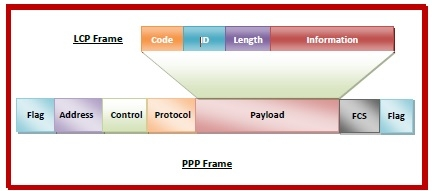
Fig 2: LCP frame
Key takeaway
Link Control Protocol (LCP) is a data link layer protocol that is part of the Point-to-Point Protocol (PPP). It is in charge of setting up, configuring, testing, managing, and terminating transmission lines.
The Network Control Protocol (NCP) is a group of protocols that make up the Point-to-Point Protocol (PPP). PPP is a data link layer protocol for sending multiprotocol data between two computers that are connected directly (point-to-point). Link control protocol (LCP), authentication protocol (AP), and network control protocol (NCP) make up PPP (NCP). NCPs are used to negotiate the network layer's parameters and facilities. One NCP exists for each higher-layer protocol supported by PPP.
The layer in which NCPs work is depicted in the diagram below:

Fig 3: NCP
List of NCPs
Some of the NCPs include:
● Internet Protocol Control Protocol (IPCP) − Over a PPP link, IPCP establishes and configures Internet Protocol (IP). It configures IP addresses on both ends of the PPP link, as well as enabling and disabling IP protocol modules.
● OSI Network Layer Control Protocol (OSINLCP) - OSINLCP is responsible for configuring, enabling, and disabling OSI protocol modules on both ends of the PPP link.
● Internetwork Packet Exchange Control Protocol (IPXCP) − Configuring, enabling, and disabling the Internet Packet Exchange (IPX) modules on both ends of the PPP link are among OSINLCP's responsibilities.
● DECnet Phase IV Control Protocol (DNCP) − This is in charge of setting up and configuring Digital's DNA Phase IV Routing protocol (DECnet Phase IV) modules over a PPP connection.
● NetBIOS Frames Control Protocol (NBFCP) − The NetBIOS Frames (NBF) protocol is a network layer protocol that is not routable. On both ends of the PPP link, NBFCP is in charge of configuring, enabling, and silencing the NBF protocol modules.
● IPv6 Control Protocol (IPV6CP) − IPV6CP is a programme that configures IPv6 addresses. It also allows you to enable and disable IP protocol modules through PPP.
Key takeaway
The Network Control Protocol (NCP) is a group of protocols that make up the Point-to-Point Protocol (PPP). PPP is a data link layer protocol for sending multiprotocol data between two computers that are connected directly (point-to-point).
Fiber Distributed Data Interface is the acronym for Fiber Distributed Data Interface. It's an optical transmission-based high-speed, high-bandwidth network. It's most commonly used as a network backbone for connecting high-end computers (mainframes, minicomputers, and peripherals), as well as LANs connecting high-performance engineering, graphics, and other workstations that require fast data transfer. It supports up to 500 stations on a single network and can transfer data at a rate of 100 Megabits per second.
FDDI was designed to transport information between stations through fiber cables using light pulses, but it can alternatively run on copper using electrical signals. It is relatively expensive to implement, though the cost can be reduced by combining fiber-optic and copper wiring.
Because FDDI networks are made up of two counter-rotating rings, they are extremely dependable. In the case that the primary ring fails, a secondary ring provides an alternative data flow. To route traffic around the problem, FDDI stations add this auxiliary ring into the data line. FDDI with token passing and a ring topology. In the form of a token ring over optical fiber, it is a cutting-edge technology. FDDI was created for two main reasons: to support and help extend the capabilities of older LANs like Ethernet and Token Ring, as well as to provide a stable infrastructure for enterprises, allowing them to move even mission-critical applications to networks.
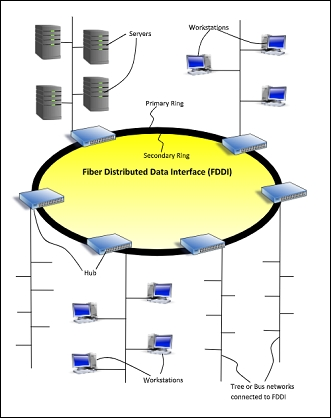
Fig 4: FDDI
FDDI Features
In terms of fault-tolerance and integrated network management features, FDDI is an effective network topology. FDDI guarantees excellent aggregated throughput rates, even in large and high-traffic networks, because to its deterministic access mechanisms. FDDI may be simply implemented as a robust backbone to current network topologies (such as Ethernet and Token Ring) to solve severe network bottlenecks in LANs.
The following features are available with FDDI:
● Broadband and high transmission speeds (100 Mbps).
● A real throughput rate of approximately 95 Mbps is expected (20 stations).
● Extensive expansions (max. 100 km).
● Extremely long node-to-node distance (2km using multimode fiber, 40 km using single mode fiber).
● Fiber and copper media are both supported.
● Easier to keep up with.
● Compatible with a variety of operating systems and standards-based components.
Frame Format
As indicated in the diagram, the frame format of FDDI is identical to that of token bus.
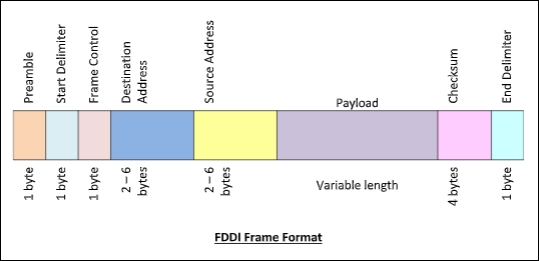
Fig 5: Frame format
An FDDI frame's fields are as follows:
● Preamble - 1 byte for synchronization.
● Start Delimiter - 1 byte that marks the beginning of the frame.
● Frame Control - A single byte that indicates whether the frame is a data or control frame.
● Destination Address - 2-6 bytes that specifies address of destination station.
● Source Address - 2-6 bytes that specifies address of source station.
● Payload - A variable length field that carries the data from the network layer.
● Checksum - 4 bytes frame check sequence for error detection.
● End Delimiter - 1 byte that marks the end of the frame.
Characteristics of FDDI
● FDDI provides a data rate of 100 Mbps.
● FDDI is made up of two interfaces.
● It's used to connect the ring to the equipment over extended distances.
● FDDI could be used to create a LAN with Station Management.
● Allows all stations to have reached a point of parity in terms of the amount of time it takes to transmit data.
● FDDI distinguishes between synchronous and asynchronous traffic.
Advantages of FDDI
● Signals are transmitted via fiber optic cables over distances of up to 200 kilometers.
● It is possible to meet the demand at the workstations linked to the chain. As a result, a few stations are bypassed based on the requirement in order to provide faster service to the rest.
● FDDI makes use of a variety of tokens to organize speed.
● It has a greater capability for transmission (up to 250 Gbps). As a result, it can manage data speeds of up to 100 Mbps.
● Because spying on the fiber-optic link is difficult, it provides high security.
● Fiber optic cable is less likely to break than other types of cable.
Disadvantages of FDDI
● FDDI is a complicated topic. As a result, setup and support necessitate a tremendous amount of knowledge.
● FDDI is not cheap. Fiber optic cable, connections, and concentrators are typically extremely expensive.
Key takeaway
Fiber Distributed Data Interface is the acronym for Fiber Distributed Data Interface. It's an optical transmission-based high-speed, high-bandwidth network.
The Token Bus (IEEE 802.4) is a standard for deploying token ring in LANs over a virtual ring. The physical medium uses coaxial cables and has a bus or tree architecture. The nodes/stations form a virtual ring, and the token is transmitted from one node to the next in a sequence along the virtual ring. Each node knows the address of the station before it and the station after it. When a station has the token, it can only broadcast data. The token bus works in a similar way as the Token Ring.
Token bus protocols, as opposed to Ethernet's baseband transmission mechanism, are classified by the IEEE 802.4 Committee as broadband computer networks. The token bus is a linear or tree-shape cable to which the stations are connected physically.
The computer network's topology can contain clusters of workstations connected by long trunk lines. The stations are arranged in a ring logically. The network has both a bus and a star topology because these workstations branch from hubs in a star layout. The token bus architecture is ideal for groups of users that are separated by a significant distance. Using a bus architecture, IEEE 802.4 token bus networks are built with 75-ohm coaxial wire. The 802.4 standard's broadband capabilities allow transmission over several channels at the same time.
The highest-numbered station may send the first frame when the logical ring is initialized. Following the numeric sequence of the station addresses, tokens and data frames are sent from one station to the next. As a result, rather than following a physical ring, the token follows a logical ring. The token is returned to the first station by the last station in numerical sequence. The token does not adhere to the physical order of workstation cable installation. Station 1 might be on one end of the cable, station 2 on the other, and station 3 somewhere in the middle.
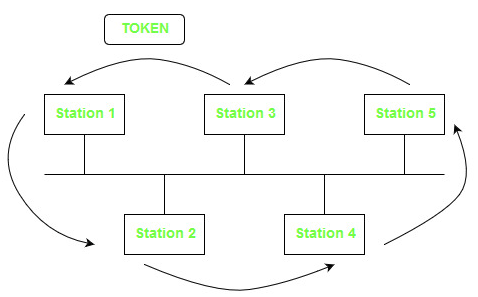
Fig 6: Token bus
Frame Format of Token Bus

Fig 7: Frame format
● Preamble – It's used to synchronize bits. It's a one-byte field.
● Start Delimiter – The start of frame is marked by these bits. It's a one-byte field.
● Frame Control – The type of frame – data frame or control frame – is specified in this field. It's a one-byte field.
● Destination Address – The destination address is stored in this field. It's a 2-to-6-byte field.
● Source Address – The source address is stored in this field. It's a 2-to-6-byte field.
● Data – If 2 byte addresses are utilized, the field can be up to 8182 bytes, whereas 6 byte addresses can be up to 8174 bytes.
● Checksum – The checksum bits in this field are used to detect mistakes in the sent data. It's a four-byte field.
● End Delimiter – This field marks the end of the frame. It is 1 byte field.
Key takeaway
The Token Bus (IEEE 802.4) is a standard for deploying token ring in LANs over a virtual ring. The physical medium uses coaxial cables and has a bus or tree architecture. The nodes/stations form a virtual ring, and the token is transmitted from one node to the next in a sequence along the virtual ring.
In a local area network (LAN), token ring (IEEE 802.5) is a communication protocol in which all stations are connected in a ring topology and pass one or more tokens for channel acquisition. A token is a three-byte special frame that passes around the ring of stations. Only a station with a token can deliver data frames. When the data frame is successfully received, the tokens are released.
When a station receives a token and has a frame to broadcast, it transmits the frame before passing the token to the next station; otherwise, it just passes the token to the next station. Receiving the token from the preceding station and transmitting it to the succeeding station is referred to as passing the token. In the direction of token passing, the data flow is unidirectional. To prevent tokens from being circulated indefinitely, they are withdrawn from the network once their function has been fulfilled. This is depicted in the diagram below.
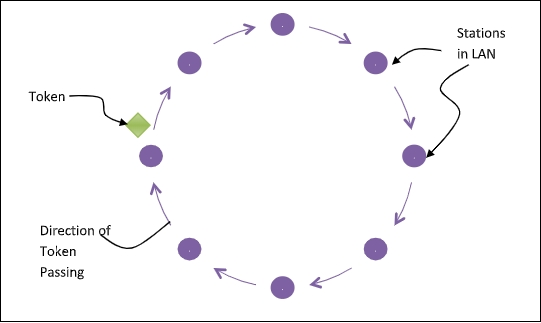
Fig 8: Token ring
Difference between token ring and token bus
Token Ring | Token Bus |
The token is passed through the coaxial cable network and the physical ring formed by the stations. | The token is passed around a LAN's virtual ring of connected stations. |
Ring topology, or star topology, is used to connect the stations. | The bus or tree topology that connects the stations is the underlying topology. |
It is defined by IEEE 802.5 standard. | It is defined by IEEE 802.4 standard. |
Here you may calculate the maximum time a token will take to reach a station. | The time it takes to transfer tokens cannot be calculated. |
Key takeaway
A token is a three-byte special frame that passes around the ring of stations. Only a station with a token can deliver data frames. When the data frame is successfully received, the tokens are released.
Reservation protocols are a type of protocol in which stations that want to send data publicize themselves before sending it. These protocols operate at the OSI model's medium access control (MAC) and transport layers.
Prior to transmission, these protocols have a contention period. Each station broadcasts their demand for transmission during the contention period. Following each station's announcement, one of them is assigned network resources depending on any agreed-upon criteria. All collisions are eliminated since each station has complete information of whether or not every other station intends to transmit before actual transmission.
A situation with five stations and a five-slot reservation frame is depicted in the diagram below. Only stations 1, 3, and 4 have made bookings for the first interval. Only station 1 has made a reservation for the second period.

Fig 9: Reservation frame
Examples of Reservation Protocols
The two most well-known reservation protocols are
● Bitmap Protocol is a MAC layer protocol that works with bits.
● The Resource Reservation Protocol (RSVP) is a transport layer protocol.
Bit – Map Protocol
The contention period is divided into N slots in this protocol, where N is the total number of stations sharing the channel. A station sets the relevant bit in the slot if it has a frame to send.
Assume there are ten stations. As a result, there will be ten contention slots. Stations 2, 3, 8, and 9 will set the respective slots to 1 if they choose to transmit. The transmission is usually carried out in the sequence of the slot numbers.
Resource Reservation Protocol (RSVP)
RSVP is a transport layer protocol that is used to reserve resources in a computer network in order to access Internet applications with a higher quality of service (QoS). It uses the Internet protocol (IP) to make resource reservations on behalf of the recipient. It's used for both unicasting (sending data from a single source to a single destination) and multicasting (sending data from multiple sources to multiple destinations) (sending data simultaneously to a group of destination computers).
Key takeaway
Reservation protocols are a type of protocol in which stations that want to send data publicize themselves before sending it. These protocols operate at the OSI model's medium access control (MAC) and transport layers.
The polling procedure is analogous to a roll call in class. A controller, like the instructor, sends a message to each node in turn. One serves as the primary station (controller), while the others serve as subsidiary stations. All data must be exchanged through the controller.
The address of the node being selected for access is included in the message sent by the controller. Although all nodes get the message, only the one to which it is directed responds and provides data, if any. If there is no data, a "poll reject" (NAK) message is normally returned. The polling messages have a large overhead, and the controller's reliability is highly dependent.
What was the first thing the teacher did when he or she entered the classroom at your high school or college? Roll call or attendance is the answer. Let's have a look at the two scenarios. When the teacher calls roll number 1 and receives a response if he or she is present, the teacher moves on to the next roll number, say roll number 2, and roll number 2 is absent, the teacher receives no response or a negative reaction. In a computer network, there is a primary station (teacher) and all other stations (students), and the primary station transmits a message to each station. The address of the station chosen for giving access is included in the message sent by the primary station.
The important thing to note is that all nodes receive the message, but only the addressed one reacts by sending data; if the station has no data to broadcast, it sends a message known as Poll Reject or NAK (negative acknowledgment).
However, this system has significant disadvantages, such as the high overhead of polling messages and the great reliance on the primary station's reliability.
We calculate the effectiveness of this strategy in terms of polling time and data transfer time.
Tpoll = time for polling
Tt = time required for transmission of data
So, efficiency = Tt / (Tt + Tpoll)
When a primary station needs data, it asks the secondary stations in its channel; this approach is known as polling. The primary station asks station A if it has any data ready for transmission; because A does not have any data queued for transmission, it sends NAK (negative acknowledgement); and then it asks station B; since B has data ready for transmission, it transmits the data and receives acknowledgement from primary station.
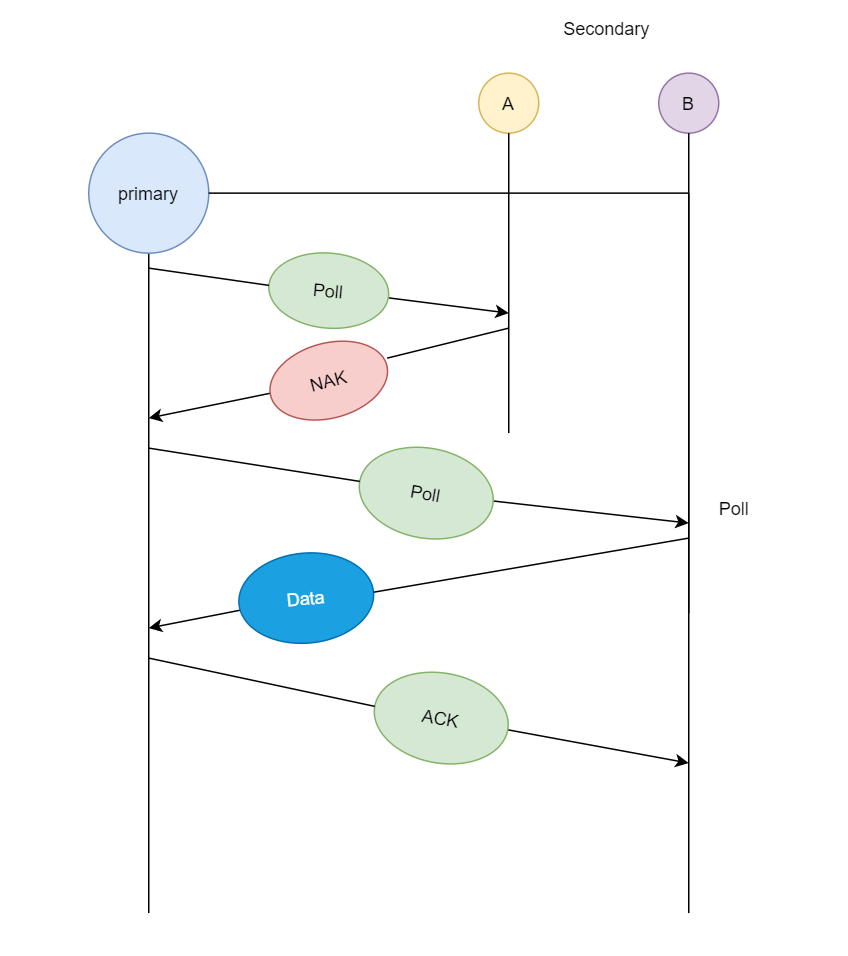
If the primary station wants to send data to the secondary stations, it sends a select message, and if the secondary station accepts the request, it sends back an acknowledgement, after which the primary station transmits the data and receives an acknowledgement.
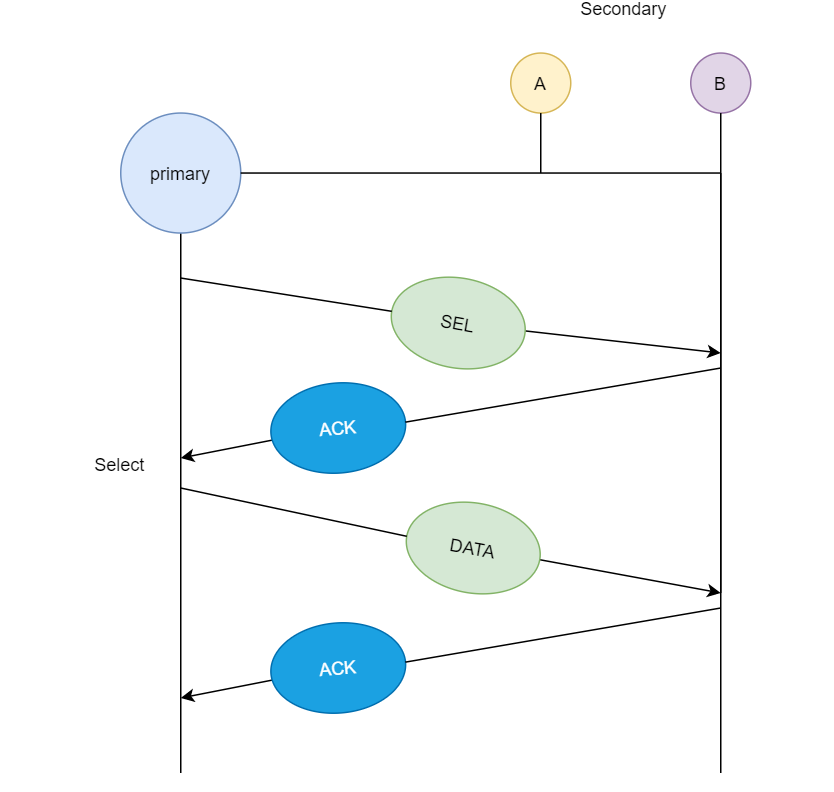
Key takeaway
The polling procedure is analogous to a roll call in class. A controller, like the instructor, sends a message to each node in turn.
One serves as the primary station (controller), while the others serve as subsidiary stations. All data must be exchanged through the controller.
When a sender and receiver have a dedicated link to transmit data packets, the data link control is enough to handle the channel. Suppose there is no dedicated path to communicate or transfer the data between two devices. In that case, multiple stations access the channel and simultaneously transmit the data over the channel. It may create collisions and cross talk. Hence, the multiple access protocol is required to reduce the collision and avoid crosstalk between the channels.
For example, suppose that there is a classroom full of students. When a teacher asks a question, all the students (small channels) in the class start answering the question at the same time (transferring the data simultaneously). All the students respond at the same time due to which data overlap or data is lost. Therefore it is the responsibility of a teacher (multiple access protocol) to manage the students and give them one answer.
Following are the types of multiple access protocol that is subdivided into the different process as:
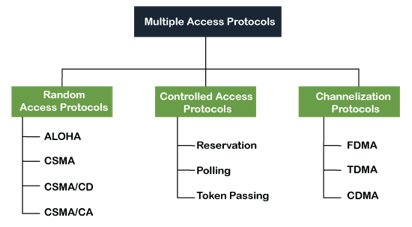
Fig 10: Types of multiple access protocol
A. Random Access Protocol
In this protocol, all the stations have the equal priority to send the data over a channel. In the random access protocol, one or more stations cannot depend on another station nor any station control another station. Depending on the channel's state (idle or busy), each station transmits the data frame. However, if more than one station sends the data over a channel, there may be a collision or data conflict. Due to the collision, the data frame packets may be lost or changed. And hence, it does not receive by the receiver end.
Following are the different methods of random-access protocols for broadcasting frames on the channel.
● Aloha
● CSMA
● CSMA/CD
● CSMA/CA
ALOHA Random Access Protocol
It is designed for wireless LAN (Local Area Network) but can also be used in a shared medium to transmit data. Using this method, any station can transmit data across a network simultaneously when a data frameset is available for transmission.
Aloha Rules
- Any station can transmit data to a channel at any time.
- It does not require any carrier sensing.
- Collisions and data frames may be lost during the transmission of data through multiple stations.
- Acknowledgment of the frames exists in Aloha. Hence, there is no collision detection.
- It requires retransmission of data after some random amount of time.

Fig 11: Types of ALOHA
Pure Aloha
Whenever data is available for sending over a channel at stations, we use Pure Aloha. In pure Aloha, when each station transmits data to a channel without checking whether the channel is idle or not, the chances of collision may occur, and the data frame can be lost. When any station transmits the data frame to a channel, the pure Aloha waits for the receiver's acknowledgment. If it does not acknowledge the receiver ends within the specified time, the station waits for a random amount of time, called the backoff time (Tb). And the station may assume the frame has been lost or destroyed. Therefore, it retransmits the frame until all the data are successfully transmitted to the receiver.
- The total vulnerable time of pure Aloha is 2 * Tfr.
- Maximum throughput occurs when G = 1/ 2 that is 18.4%.
- Successful transmission of data frame is S = G * e ^ - 2 G.
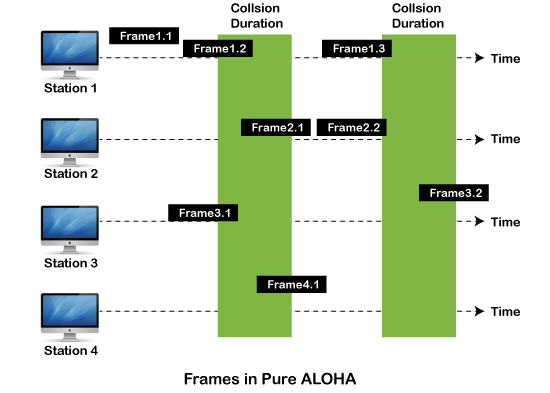
Fig 12: Frames in pure aloha
As we can see in the figure above, there are four stations for accessing a shared channel and transmitting data frames. Some frames collide because most stations send their frames at the same time. Only two frames, frame 1.1 and frame 2.2, are successfully transmitted to the receiver end. At the same time, other frames are lost or destroyed. Whenever two frames fall on a shared channel simultaneously, collisions can occur, and both will suffer damage. If the new frame's first bit enters the channel before finishing the last bit of the second frame. Both frames are completely finished, and both stations must retransmit the data frame.
Slotted Aloha
The slotted Aloha is designed to overcome the pure Aloha's efficiency because pure Aloha has a very high possibility of frame hitting. In slotted Aloha, the shared channel is divided into a fixed time interval called slots. So that, if a station wants to send a frame to a shared channel, the frame can only be sent at the beginning of the slot, and only one frame is allowed to be sent to each slot. And if the stations are unable to send data to the beginning of the slot, the station will have to wait until the beginning of the slot for the next time. However, the possibility of a collision remains when trying to send a frame at the beginning of two or more station time slot.
- Maximum throughput occurs in the slotted Aloha when G = 1 that is 37%.
- The probability of successfully transmitting the data frame in the slotted Aloha is S = G * e ^ - 2 G.
- The total vulnerable time required in slotted Aloha is Tfr.
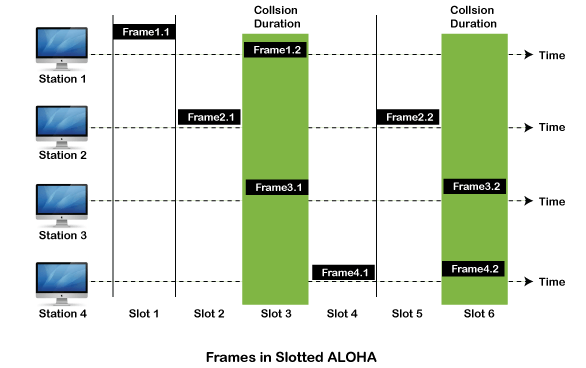
Fig 13: Frames in slotted aloha
Difference Between Pure Aloha and Slotted Aloha-
Pure Aloha | Slotted Aloha |
Any station can transmit the data at any time. | Any station can transmit the data at the beginning of any time slot. |
The time is continuous and not globally synchronized. | The time is discrete and globally synchronized. |
Vulnerable time in which collision may occur = 2 x Tt | Vulnerable time in which collision may occur = Tt |
Probability of successful transmission of data packet = G x e-2G | Probability of successful transmission of data packet = G x e-G |
Maximum efficiency = 18.4% (Occurs at G = 1/2) | Maximum efficiency = 36.8% ( Occurs at G = 1) |
The main advantage of pure aloha is its simplicity in implementation. | The main advantage of slotted aloha is that it reduces the number of collisions to half and doubles the efficiency of pure aloha. |
Key takeaway
It is designed for wireless LAN (Local Area Network) but can also be used in a shared medium to transmit data. Using this method, any station can transmit data across a network simultaneously when a data frameset is available for transmission.
In pure Aloha, when each station transmits data to a channel without checking whether the channel is idle or not, the chances of collision may occur, and the data frame can be lost.
The slotted Aloha is designed to overcome the pure Aloha's efficiency because pure Aloha has a very high possibility of frame hitting.
It is a carrier-sense multiple access based on media access protocol to sense the traffic on a channel (idle or busy) before transmitting the data. It means that if the channel is idle, the station can send data to the channel. Otherwise, it must wait until the channel becomes idle. Hence, it reduces the chances of a collision on a transmission medium.
CSMA is a network access mechanism for controlling network access on shared network topologies like Ethernet. Before sending, devices connected to the network cable listen (carrier sense). Devices wait before broadcasting if the channel is in use. Multiple Access (MA) refers to the ability for multiple devices to connect to and share the same network. When the network is clear, all devices have equal access to it.
To put it another way, a station that wishes to communicate first "listens" to media communication and then waits for a "quiet" of a certain length of time (called the Distributed Inter Frame Space or DIFS). Following this mandatory interval, the station begins a countdown for a random period.
The collision window is the maximum duration of this countdown (Window Collision, CW). If no equipment talks before the countdown ends, the station will just deliver the gift. If it is surpassed by another station, however, it immediately stops counting and waits for the next moment of stillness. She then picked up where his account countdown had left off. Figure summarizes this information. The random waiting time has the advantage of permitting a statistically equitable allocation of speaking time between the various network equipment while making it rare (but not impossible) that both devices speak at the same time.
The countdown method prevents a station from delaying the delivery of its cargo for too long. It's a little like what happens in a conference room where no master session (and everyone in the world is courteous) expects stillness before speaking, then a few moments before speaking, to give someone else a chance to talk. The time is allotted at random, which means that it is distributed fairly evenly.
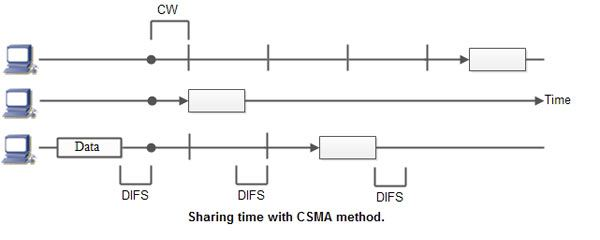
CSMA Access Modes
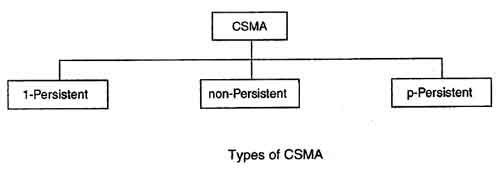
1-Persistent: In the 1-Persistent mode of CSMA that defines each node, first sense the shared channel and if the channel is idle, it immediately sends the data. Else it must wait and keep track of the status of the channel to be idle and broadcast the frame unconditionally as soon as the channel is idle.
Non-Persistent: It is the access mode of CSMA that defines before transmitting the data, each node must sense the channel, and if the channel is inactive, it immediately sends the data. Otherwise, the station must wait for a random time (not continuously), and when the channel is found to be idle, it transmits the frames.
P-Persistent: It is the combination of 1-Persistent and Non-persistent modes. The P-Persistent mode defines that each node senses the channel, and if the channel is inactive, it sends a frame with a P probability. If the data is not transmitted, it waits for a (q = 1-p probability) random time and resumes the frame with the next time slot.
O- Persistent: It is an O-persistent method that defines the superiority of the station before the transmission of the frame on the shared channel. If it is found that the channel is inactive, each station waits for its turn to retransmit the data.
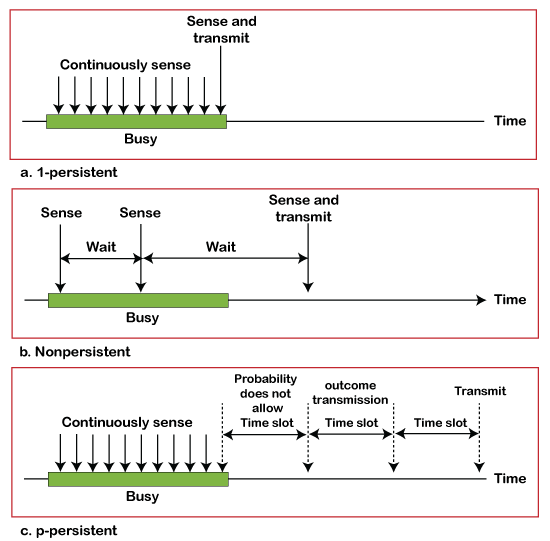
Fig 14: CSMA access modes
CSMA/ CD
It is a carrier sense multiple access/ collision detection network protocol to transmit data frames. The CSMA/CD protocol works with a medium access control layer. Therefore, it first senses the shared channel before broadcasting the frames, and if the channel is idle, it transmits a frame to check whether the transmission was successful. If the frame is successfully received, the station sends another frame. If any collision is detected in the CSMA/CD, the station sends a jam/ stop signal to the shared channel to terminate data transmission. After that, it waits for a random time before sending a frame to a channel.
CSMA/ CA
It is a carrier sense multiple access/collision avoidance network protocol for carrier transmission of data frames. It is a protocol that works with a medium access control layer. When a data frame is sent to a channel, it receives an acknowledgment to check whether the channel is clear. If the station receives only a single (own) acknowledgment, that means the data frame has been successfully transmitted to the receiver. But if it gets two signals (its own and one more in which the collision of frames), a collision of the frame occurs in the shared channel. Detects the collision of the frame when a sender receives an acknowledgment signal.
Following are the methods used in the CSMA/ CA to avoid the collision:
Interframe space: In this method, the station waits for the channel to become idle, and if it gets the channel is idle, it does not immediately send the data. Instead of this, it waits for some time, and this time period is called the Interframe space or IFS. However, the IFS time is often used to define the priority of the station.
Contention window: In the Contention window, the total time is divided into different slots. When the station/ sender is ready to transmit the data frame, it chooses a random slot number of slots as wait time. If the channel is still busy, it does not restart the entire process, except that it restarts the timer only to send data packets when the channel is inactive.
Acknowledgment: In the acknowledgment method, the sender station sends the data frame to the shared channel if the acknowledgment is not received ahead of time.
B. Controlled Access Protocol
It is a method of reducing data frame collision on a shared channel. In the controlled access method, each station interacts and decides to send a data frame by a particular station approved by all other stations. It means that a single station cannot send the data frames unless all other stations are not approved. It has three types of controlled access: Reservation, Polling, and Token Passing.
C. Channelization Protocols
It is a channelization protocol that allows the total usable bandwidth in a shared channel to be shared across multiple stations based on their time, distance and codes. It can access all the stations at the same time to send the data frames to the channel.
Following are the various methods to access the channel based on their time, distance and codes:
- FDMA (Frequency Division Multiple Access)
- TDMA (Time Division Multiple Access)
- CDMA (Code Division Multiple Access)
Key takeaway
CSMA is a network access mechanism for controlling network access on shared network topologies like Ethernet.
It is a carrier sense multiple access/collision avoidance network protocol for carrier transmission of data frames. It is a protocol that works with a medium access control layer.
It's an FDMA (frequency division multiple access) approach that divides the available bandwidth into equal bands so that many users can submit data to the subchannel using various frequencies. To prevent crosstalk between channels and station interference, each station is assigned to a specific band.
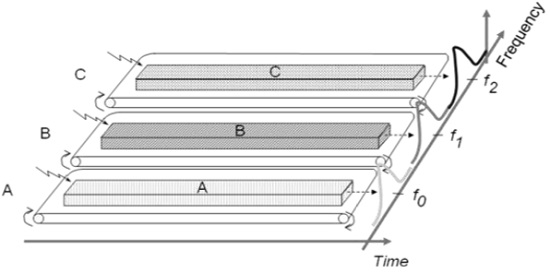
Fig 15: FDMA
Advantages of FDMA
FDMA systems provide the following advantages over average delay spread because they use low bit rates (long symbol time).
● Reduces bit rate information while increasing capacity through the use of efficient numerical coding.
● It saves money and reduces inter-symbol interference (ISI).
● Equalization isn't required.
● An FDMA system is simple to set up. It is possible to configure a system so that advances in voice encoder and bit rate reduction can be easily implemented.
● Because the transmission is continuous, synchronization and framing requires less bits.
Disadvantages of FDMA
Although FDMA provides various benefits, it also has a few disadvantages, which are stated below.
● It is similar to analogue systems in that increasing capacity requires signal-to-interference reduction, or a signal-to-noise ratio (SNR).
● Per channel, the maximum flow rate is fixed and minimal.
● The use of guard bands wastes capacity.
● Narrowband filters require hardware, which cannot be implemented in VLSI and hence raises the cost.
Key takeaway
It's an FDMA (frequency division multiple access) approach that divides the available bandwidth into equal bands so that many users can submit data to the subchannel using various frequencies.
A channel access method is Time Division Multiple Access (TDMA). It permits numerous stations to share the same frequency bandwidth. It also separates the shared channel into different frequency slots that assign stations to broadcast data frames to avoid collisions. By dividing the signal into several time slots to transmit it, the same frequency bandwidth can be shared over a shared channel. However, TDMA has a synchronization overhead that adds synchronization bits to each slot to specify each station's time slot.
Because it necessitates precise synchronization between the transmitter and the receiver, Time Division Multiple Access (TDMA) is a complicated technology. In digital mobile radio systems, TDMA is used. Individual mobile stations assign a frequency for the exclusive use of a time interval on a cyclical basis.
In most circumstances, a station is not granted the entire system bandwidth for a given period of time. However, the system's frequency is divided into sub-bands, with each sub-band using TDMA for multiple access. Carrier frequencies refer to sub-bands. Multi-carrier systems refer to mobile systems that employ this method.
The frequency band has been shared by three users in the following example. Each user is given specific timeslots during which they can send and receive data. User 'B' transmits after user 'A,' and user 'C' sends after user 'A,' in this example. As a result, peak power becomes a concern, which is exacerbated by burst communication.
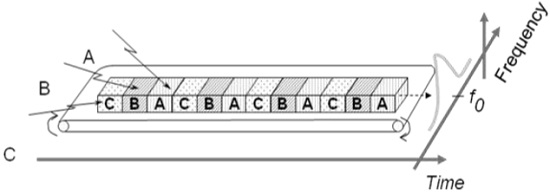
Fig 16: TDMA
Advantages of TDMA
Here is a list of TDMA's most prominent benefits:
● Allows for rate flexibility (i.e. several slots can be assigned to a user, for example, each time interval translates 32Kbps, a user is assigned two 64 Kbps slots per frame).
● Can handle high-volume or variable-bit-rate traffic. Frame by frame, the number of slots allotted to a user can be modified (for example, two slots in the frame 1, three slots in the frame 2, one slot in the frame 3, frame 0 of the notches 4, etc.).
● The wideband method does not require a guard band.
● The wideband system does not require a narrowband filter.
Disadvantages of TDMA
The following are TDMA's drawbacks:
● Broadband systems with high data rates necessitate complicated equalization.
● The burst mode necessitates a considerable number of additional bits for synchronization and supervision.
● In order to accommodate time to inaccuracies, each slot requires call time (due to clock instability).
● Electronics that operate at high bit rates consume more energy.
● To synchronize within brief slots, complex signal processing is required.
Key takeaway
TDMA has a synchronization overhead that adds synchronization bits to each slot to specify each station's time slot.
A channel access method is code division multiple access (CDMA). In CDMA, all stations can transfer data over the same channel at the same time. It means that each station can transmit data frames on the shared channel at full frequency at all times. It does not necessitate the use of time slots to divide bandwidth on a shared channel. A unique code sequence separates the data frames of many stations sending data to the same channel at the same time.
For data transmission across a common channel, each station has its own unique code. In a room, for example, there are numerous users who are always speaking. When only two people connect with each other using the same language, data is received by the users. Similarly, if different stations in the network interact with each other at the same time using different code languages, the network will be disrupted.
Working of CDMA
By processing each voice packet with two PN codes, CDMA supports up to 61 concurrent users on a 1.2288 MHz channel. To distinguish between calls and theoretical limits, there are 64 Walsh codes available. The maximum number of calls will be reduced somewhat below this value due to operational constraints and quality difficulties.
Many separate "signals" baseband with different spreading codes can be modulated on the same carrier to support a wide range of users. The interference between the signals is negligible when using distinct orthogonal codes. When signals are received from multiple mobile stations, the base station may isolate each one since their orthogonal spreading codes are distinct.
The complexity of the CDMA system is depicted in the diagram below. We mixed the signals of all users during propagation, but you utilize the identical code that was used at the time of transmission on the receiving side. Only the signal of each user can be removed.
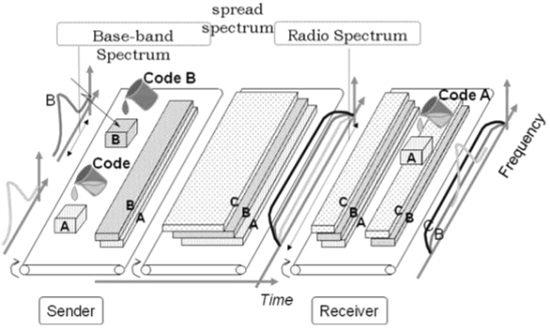
Fig 17: CDMA
Advantages of CDMA
The CDMA network has a soft capacity. The more codes there are, the more people who can use them. It has the following benefits:
● Because of the near-far effect, CDMA requires precise power regulation. In other words, a user transmitting at the same power level as the base station will drown the signal. At the receiver, all signals must have roughly equal power.
● Signal reception can be improved by using rake receivers. Multipath signals (delayed versions of time (a chip or later)) can be gathered and used to make judgments at the bit level.
● It is possible to employ a flexible transfer. Without changing operators, mobile base stations can switch. Two base stations receive mobile signal and the mobile receives signals from the two base stations.
● Transmission Burst − reduces interference.
Disadvantages of CDMA
The following are some of the downsides of employing CDMA:
● The length of the code must be carefully chosen. A long code length might create lag or even interference.
● It is necessary to synchronize the time.
● Gradual transfer makes better use of radio resources while potentially reducing capacity.
● The amount of the power received and broadcast by a base station necessitates strict power regulation at all times. This may necessitate many handovers.
Key takeaway
A channel access method is code division multiple access (CDMA). In CDMA, all stations can transfer data over the same channel at the same time. It means that each station can transmit data frames on the shared channel at full frequency at all times.
The most widely used physical layer LAN technology today is Ethernet. It specifies the amount of conductors necessary for a connection, as well as the expected performance levels and the data transmission structure. Data can be transmitted at a rate of up to 10 Megabits per second over a conventional Ethernet network (10 Mbps). Token Ring, Fast Ethernet, Gigabit Ethernet, 10 Gigabit Ethernet, Fiber Distributed Data Interface (FDDI), Asynchronous Transfer Mode (ATM) and LocalTalk are examples of other LAN technologies.
Ethernet is popular because it provides an excellent blend of speed, cost, and installation ease. Ethernet is a suitable networking technology for most computer users today because of these advantages, as well as its widespread popularity in the computer market and its ability to support practically all major network protocols.
IEEE Standard 802.3 is an Ethernet standard developed by the Institute of Electrical and Electronic Engineers. This standard outlines how the pieces of an Ethernet network communicate with one another as well as the rules for creating an Ethernet network. Network equipment and protocols can communicate more efficiently if they follow the IEEE standard.
Advantages
● Creating an Ethernet network is not expensive. It is relatively affordable when compared to other computer networking solutions.
● In terms of data security, the Ethernet network uses firewalls to ensure excellent protection for data.
● Furthermore, the Gigabit network allows users to send data at speeds ranging from 1-100 Gbps.
● The data transfer quality is maintained in this network.
● Administration and maintenance are simplified with this network.
● The latest versions of gigabit ethernet and wireless ethernet can carry data at speeds of up to 100 gigabits per second.
Disadvantages
● It requires deterministic service, hence it isn't recommended for real-time applications.
● In terms of distance, the wired Ethernet network is limited, and therefore is best used for small distances.
● The cost of installing a wired ethernet network, which requires cables, hubs, switches, and routers, rises.
● In an interactive programme, data must be transferred quickly, and the data must be minimal.
● After accepting a packet in an Ethernet network, the receiver does not provide any acknowledgement.
● If you have no previous experience with networks, setting up a wireless Ethernet network can be challenging.
● The wireless network is not more secure than the traditional Ethernet network.
● The 100Base-T4 version does not provide full-duplex data transfer.
● Furthermore, locating a fault in an Ethernet network (assuming one exists) is challenging because it is difficult to tell which node or cable is causing the issue.
Key takeaway
Ethernet is popular because it provides an excellent blend of speed, cost, and installation ease.
For Ethernet networks that require faster transmission speeds, the Fast Ethernet standard (IEEE 802.3u) was created. With just minor changes to the existing wire topology, this standard doubles the Ethernet speed limit from 10 Mbps to 100 Mbps. Fast Ethernet delivers higher error detection and correction, as well as quicker throughput for video, multimedia, graphics, and Internet surfing.
Fast Ethernet is divided into three categories: 100BASE-TX for use with level 5 UTP cable, 100BASE-FX for use with fiber-optic cable, and 100BASE-T4 for use with level 3 UTP cable. Because of its tight compatibility with the 10BASE-T Ethernet standard, the 100BASE-TX standard has become the most common.
Many decisions must be made by network managers who want to implement Fast Ethernet into an existing system. The number of users who require higher throughput in each network site must be established, as well as which segments of the backbone must be upgraded expressly for 100BASE-T and what hardware is required to connect the 100BASE-T segments with existing 10BASE-T segments. Gigabit Ethernet is a future technology that promises a migration path beyond Fast Ethernet, allowing for considerably faster data transmission speeds in the next generation of networks.
Varieties of Fast Ethernet
100-Base-TX, 100-BASE-FX, and 100-Base-T4 are the most prevalent types of fast Ethernet.
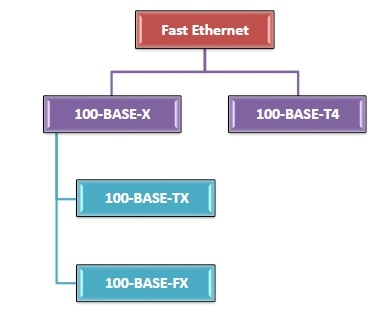
Fig 18: Types of fast ethernet
100-Base-T4
● This has four pairs of Category 3 UTP, two of which are bidirectional and two of which are unidirectional.
● Three pairs can be employed for data transfer in each direction at the same time.
● Each twisted pair can send data at a maximum rate of 25 Mbaud. As a result, the three pairs can manage up to 75Mbaud data.
● It used the 8B/6T (eight binary/six ternary) encoding technique.
100-Base-TX
● Two pairs of unshielded twisted pairs (UTP) category 5 wires or two pairs of shielded twisted pairs (STP) type 1 wires are used. One pair transfers frames from the hub to the device, while the other pair transmits frames from the device to the hub.
● The distance between the hub and the station is limited to 100 meters.
● It has a data rate of 125 megabits per second.
● It employs the MLT-3 coding technique, as well as 4B/5B block coding.
100-BASE-FX
● There are two pairs of optical fibers in this. One pair transfers frames from the hub to the device, while the other pair transmits frames from the device to the hub.
● A maximum distance of 2000 meters exists between the hub and the station.
● It has a data rate of 125 megabits per second.
● It employs the NRZ-I coding method, as well as 4B/5B block coding.
Key takeaway
Fast Ethernet delivers higher error detection and correction, as well as quicker throughput for video, multimedia, graphics, and Internet surfing.
References:
- Peterson and Davie, “Computer Networks: A Systems Approach”, Morgan Kaufmann
- W. A. Shay, “Understanding Communications and Networks”, Cengage Learning.
- D. Comer, “Computer Networks and Internets”, Pearson.
- Behrouz Forouzan, “TCP/IP Protocol Suite”, McGraw Hill.